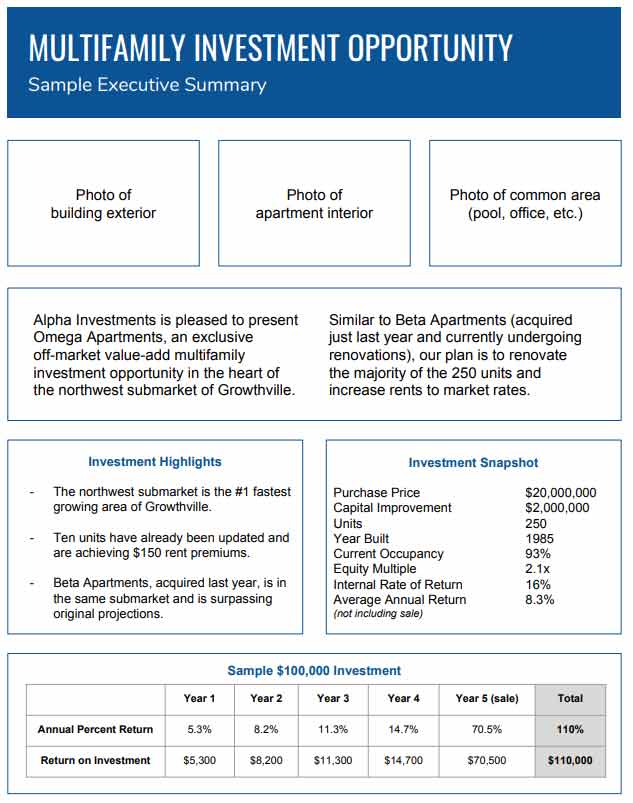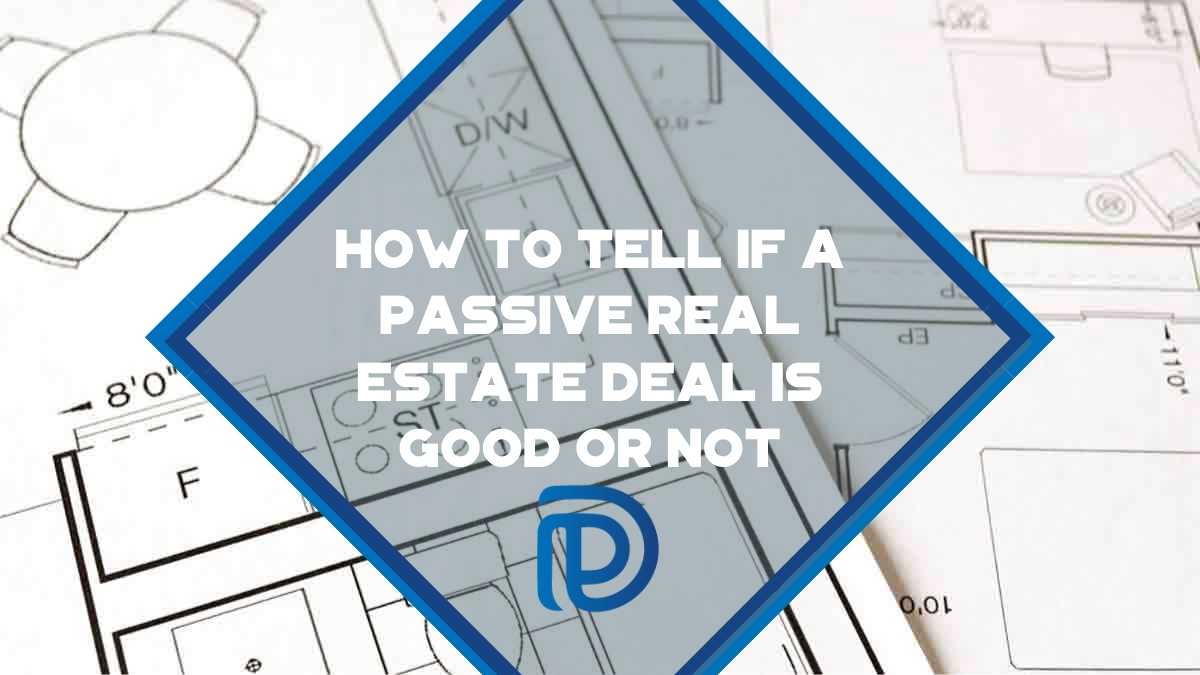Real Estate Executive Summary – What Does A Good Deal Look Like?
One of the top questions members of our Passive Investors Circle typically ask is, “What does a good real estate deal look like?”
To answer that question, we must first look at how most of the real estate syndication deals are marketed to investors.
Many times they’ll use what is called a real estate executive summary. Often, when deal sponsors are raising money for their deals, they’ll put together investment summaries to explain:
- why the deal is good
- what they plan to do with it
- how much the investors stand to gain
When you start to review these summaries you’ll quickly realize that no two are alike.
Some appear to be designed by experts with professional photos whereas others look to be thrown together in less than fifteen minutes.
But here’s the deal. Regardless of what an investment summary looks like, you must be able to look past the design aspect and evaluate the numbers and business plan for what they really are.
If you decide to invest because the investment summary looks nice, you may be putting yourself at risk, if you haven’t done proper due diligence on the deal and team.
Likewise, if you write off a deal because the investment summary looks like your teenager put it together on their iphone, then you might be missing out on a great opportunity.
At this point you maybe asking yourself, “Jeff, what exactly should I look for?”
Good question.
I learn best by examples so what I’d like to do is walk you through my thought process when I first look through a sample investment summary.
Please note: For simplicity’s sake, I’m using a one-page executive summary for this example, rather than a full-blown one, which could be dozens of pages long.
Real Estate Executive Summary – At A Glance
Even though every investment summary is different, there are some basic elements that are fairly common across all multifamily real estate syndication investment summaries:
- Project name (often the name of the apartment complex)
- Photos of the property and area
- Overview of the submarket
- Overview of the deal
- Details of the business plan
- Projected returns and exit strategies
- Detailed numbers and analyses
- Team bios
In a one-page executive summary, you get a little bit of information of the list above.
If you want all the details, you’ll have to read the full investment summary. Think of a summary as more of a Cliff Notes version.
Here’s a one page real estate executive summary example:

Whenever I first get my hands on one, I’d start skimming through and paying attention to:
- Off-market
- Value-add
- Track record
- Strong submarket
- Proven model
- Equity multiple
- Unit count
Let’s break each of these categories down a bit further….
Don’t Miss Any Updates. Each week I’ll send you advice on how to reach financial independence with passive income from real estate.
Sign up for my newsletterOff-Market
Have you ever known a home to sell in your area without ever being listed on the market? This is an example of an “off-market” deal.
When an asset is acquired off-market, it means that the seller chose not to list the asset publicly.
Why you ask? Occasionally the seller may not want the tenants to know that the building is being sold or they may need to sell within a set timeline. Another reason could be that the seller already had a buyer in mind.
Regardless, off-market is almost always a good thing. This means the deal sponsor team did not have to compete with other potential buyers on price.
Because of this, there’s a good chance that the purchase price is low, or at least very reasonable.
Value-Add
A value-add investment is exactly what it sounds like – an asset that presents an opportunity to add value in some way.
A few ways this can happen are:
- Opportunity to increase rates as the owner hasn’t done so in years
- Kitchens or other rooms could be updated
- Possible opportunity to add new additional units
I love investing in value-add assets as it means that the deal sponsor is in more control than normal. They don’t have to completely rely on market appreciation as there are things they can do to create additional equity.
Here’s an example of the power of value-add:
Let’s use the 250 unit example from the summary above.
Let’s say that the complex hasn’t been updated in over ten years and the units are renting for $1,000 per month.
Renovating each unit will not only add value to the building but also the living conditions as well.
Once residents see the updated spaces, they’re often happy to pay the higher rents and start to take more pride in their community.
After the updating is completed, the units now rent for $1,200 per month.
When you add up the $200 per month increases across all 250 units, that’s an extra $50,000 a month or $600,000 a year.
Track Record
Go back up and take a look at the real estate executive summary again. Do you notice anything that could tell you that this sponsor has a proven track record?
Here’s what stood out to me when I initially glanced at it:

This paragraph tells me that this is not the first time the sponsor has completed a project before. They’ve actually done this with another asset nearby.
Take a look in the Investment Highlights section.

You’ll notice that they’ve started implementing their business plan at Beta Apartments and that they’re surpassing their original projections.
This tells me that their business plan is working and that they would likely be able to continue to strengthen their track record through Omega Apartments.
Strong Submarket
One of my real estate investment criteria is that I choose assets located in a strong submarket. I want to be somewhere that the area is moving and shaking….meaning there’s growth and development happening.
The fact that this submarket is the “#1 fastest growing” within this area tells me that it’s in an area I’d likely want to invest in.
If I don’t know much about the area, then I’d likely start researching via Google to learn more about it.
Here’s a few things that I’d look for:
- proximity to major employers in the area/shopping centers
- good schools
- any news about developments in the area
- what it looks like on Google street view
- what nearby houses are selling for
- and anything else I can find
Much of this will be in the full investment summary, but I always like to do a little research on my own as well.
Join the Passive Investors CircleProven Model
The statement, “Ten units have already been updated and are achieving rent premiums of $150” is very important. Why?
This takes all the guesswork and assumptions out of the value-add proposal. The previous owner already created the proof of concept.
They updated a certain amount of units and were able to obtain higher rents.
This means that all they have to do is go in and continue the renovations to achieve the same rental increases.
To me, this signals much lower risk in a value-add opportunity.
Equity Multiple
A real estate executive summary has several different numbers on it and can make things confusing. But there’s one metric that I’ve come to rely on and that’s the equity multiple.
The term “equity multiple” is exactly what it sounds like.
In commercial real estate, it’s the amount that your capital, or your equity, will be multiplied over the course of the projected hold time.
Essentially, it’s how much money an investor could make on their initial investment.
Here’s the formula:

In the investment summary, the projected equity multiple is 2.1x. This means that during the life of this project, an investor’s money would more than double.
If you were to invest $100,000, you’d come out of this project with $210,000.
Let’s break this down as the $210,000 would include:
- original $100,000 investment
- $110,000 from the quarterly cash-on-cash returns & profits from the sale of the asset
Typically, I look for an equity multiple around 2x, so this one passes my test.
Unit Count
In the above example, Omega Apartments consists of 250 units. This is a fairly decent size complex.
This means that the team would be able to take advantage of economies of scale (i.e., increasing efficiencies by leveraging shared resources across the many units).
One of my investment criteria is to look at buildings having at least 50 units. Ideally, to maximize economies of scale, I like to see over 100 units.
Next Steps
At this point of the process, I’ve taken a look through the real estate executive summary and my next step would be to decide whether or not to request the full investment summary.
In this case, I would go ahead and request it, as this opportunity has most of the things I look for in a multifamily investment opportunity:
- a strong team
- strong submarket
- opportunity to add value
In the meantime, I would continue researching both the submarket and the deal sponsor team.
Move Quickly
Once you find an investment summary that meets your investment criteria, it’s critical that you move quickly. Why? Because these opportunities fill up on a first-come, first-served basis.
Chances are, if this investment opportunity met your criteria, it likely met others’ criteria as well.
Be ready to make a soft commitment to reserve your spot, then take time to review the investment summary in detail.
Passive Investors Circle
If you’re interested in learning more about creating streams of passive income streams then consider joining our Passive Investors Circle.
After joining, we’ll be able to discuss your financial goals, answer questions about passive real estate and allow you to gain access to deals in our pipeline.


